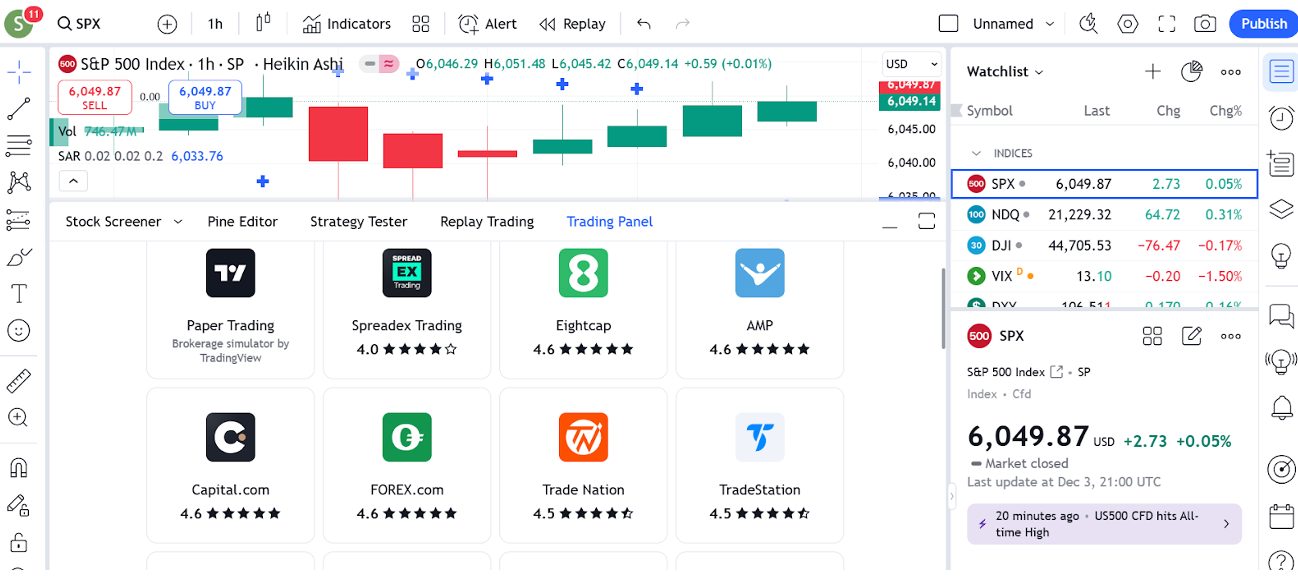Best TradingView Brokers In 2025



As active traders, industry experts, and experienced users of the software, we’ve tested and ranked the top brokers with TradingView from its growing network of 80+ partners – helping you find the best fit for your needs.
Top 6 TradingView Brokers For 2025
Our updated December 2025 rankings reveal these are the top 6 TradingView brokers :
Why Are These Brokers The Best Brokers With TradingView?
Here’s a quick rundown of why we believe these brokers are the best for TradingView integration:
- Interactive Brokers is the best TradingView broker in 2025 - Interactive Brokers offers deep TradingView integration, enabling trading across global stocks, futures, forex, and options with competitive commissions from $0.005 per share. When we tested it, order execution was highly reliable and fast. Advanced analytics and algo tools empower professional traders with rich market insights.
- IQCent - IQcent does not offer full TradingView trading integration but provides charting tools similar to TradingView’s style within its platform. During our hands-on testing, execution speeds were variable. No minimum deposits and no inactivity fees make it accessible for casual traders.
- OANDA US - OANDA US supports TradingView charting and seamless order execution on 70+ forex pairs and CFDs, with spreads from 1.0 pip and no commissions. When we tried it, execution was precise. Advanced TradingView tools help refine strategies in real time.
- FOREX.com - FOREX.com provides TradingView users with access to 80+ forex pairs and CFDs, featuring tight spreads from 0.2 pips and commission-free standard accounts. During testing, execution speed was consistent and reliable for day traders. Advanced TradingView alerts and charting boost trade timing and strategy.
- Videforex - Videforex does not offer full TradingView trading integration but provides it alongside proprietary charting tools. No minimum deposit and no inactivity fees make it beginner-friendly.
- CEX.IO - CEX.IO does not offer direct TradingView integration but supports charting tools and price alerts. In our hands-on testing of the platform, crypto trading execution was fast with competitive fees - starting around 0.25% per trade. With its sleek interface, entry is easy for casual and active crypto traders alike.
How Safe Are These Brokers That Support TradingView?
Explore the security measures at the top TradingView brokers:
| Broker | Trust Rating | Guaranteed Stop Loss | Negative Balance Protection | Segregated Accounts |
|---|---|---|---|---|
| Interactive Brokers | ✘ | ✔ | ✔ | |
| IQCent | ✘ | ✘ | ✘ | |
| OANDA US | ✔ | ✘ | ✘ | |
| FOREX.com | ✘ | ✔ | ✘ | |
| Videforex | ✔ | ✔ | ✘ | |
| CEX.IO | ✘ | ✔ | ✔ |
Compare Mobile TradingView Access
See how good the mobile TradingView experience is at our top brokers:
| Broker | Mobile Apps | iOS Rating | Android Rating | Smart Watch App |
|---|---|---|---|---|
| Interactive Brokers | iOS & Android | ✔ | ||
| IQCent | iOS & Android | ✘ | ||
| OANDA US | iOS & Android | ✘ | ||
| FOREX.com | iOS & Android | ✘ | ||
| Videforex | Android | ✘ | ||
| CEX.IO | iOS & Android | ✘ |
Are The Top TradingView Brokers Good For Beginners?
Beginners should test TradingView in a demo account and look for other features that new traders need:
| Broker | Demo Account | Minimum Deposit | Minimum Trade | Education Rating | Support Rating |
|---|---|---|---|---|---|
| Interactive Brokers | ✔ | $0 | $100 | ||
| IQCent | ✔ | $250 | $0.01 | ||
| OANDA US | ✔ | $0 | 0.01 Lots | ||
| FOREX.com | ✔ | $100 | 0.01 Lots | ||
| Videforex | ✔ | $250 | $0.01 | ||
| CEX.IO | ✘ | $20 | $1 |
Are The Top TradingView Brokers Good For Advanced Traders?
Seasoned traders should look for value-add features to take the TradingView environment to the next level:
| Broker | Automated Trading | VPS | AI | Pro Account | Leverage | Low Latency | Extended Hours |
|---|---|---|---|---|---|---|---|
| Interactive Brokers | Capitalise.ai, TWS API | ✘ | ✔ | ✘ | 1:50 | ✔ | ✔ |
| IQCent | ✘ | ✘ | ✘ | ✘ | 1:500 | ✘ | ✘ |
| OANDA US | Expert Advisors (EAs) on MetaTrader | ✘ | ✔ | ✘ | 1:50 | ✔ | ✘ |
| FOREX.com | Expert Advisors (EAs) on MetaTrader | ✔ | ✔ | ✘ | 1:50 | ✔ | ✘ |
| Videforex | ✔ | ✘ | ✘ | ✘ | 1:500 | ✘ | ✘ |
| CEX.IO | API | ✘ | ✘ | ✘ | - | ✘ | ✘ |
Compare The Ratings Of Top Brokers Supporting TradingView
Uncover how the top TradingView brokerages scored in core areas in our hands-on tests:
| Broker | Trust | Platforms | Assets | Mobile | Fees | Accounts | Research | Education | Support |
|---|---|---|---|---|---|---|---|---|---|
| Interactive Brokers | |||||||||
| IQCent | |||||||||
| OANDA US | |||||||||
| FOREX.com | |||||||||
| Videforex | |||||||||
| CEX.IO |
Compare Trading Fees
The cost of trading on TradingView adds up over time - here's how the top providers stack up on costs:
| Broker | Cost Rating | Fixed Spreads | Inactivity Fee |
|---|---|---|---|
| Interactive Brokers | ✘ | $0 | |
| IQCent | ✘ | $10 | |
| OANDA US | ✘ | $0 | |
| FOREX.com | ✘ | $15 | |
| Videforex | ✘ | $10 | |
| CEX.IO | ✘ | - |
How Popular Are These Brokers With TradingView?
As the popularity of TradingView grows, traders look for established brokers, i.e. those with the most clients:
| Broker | Popularity |
|---|---|
| CEX.IO | |
| Interactive Brokers | |
| FOREX.com | |
| Videforex |
Why Use TradingView With Interactive Brokers?
"Interactive Brokers is one of the best brokers for advanced day traders, providing powerful charting platforms, real-time data, and customizable layouts, notably through the new IBKR Desktop application. Its superb pricing and advanced order options also make it highly attractive for day traders, while its diverse range of equities is still among the best in the industry."
Christian Harris, Reviewer
Interactive Brokers Quick Facts
| Demo Account | Yes |
|---|---|
| Instruments | Stocks, Options, Futures, Forex, Funds, Bonds, ETFs, Mutual Funds, CFDs, Cryptocurrencies |
| Regulator | FCA, SEC, FINRA, CFTC, CBI, CIRO, SFC, MAS, MNB, FINMA, AFM |
| Platforms | Trader Workstation (TWS), IBKR Desktop, GlobalTrader, Mobile, Client Portal, AlgoTrader, OmniTrader, TradingView, eSignal, TradingCentral, ProRealTime, Quantower |
| Minimum Deposit | $0 |
| Minimum Trade | $100 |
| Leverage | 1:50 |
| Account Currencies | USD, EUR, GBP, CAD, AUD, INR, JPY, SEK, NOK, DKK, CHF, AED, HUF |
Pros
- The new IBKR Desktop platform takes the best of TWS while adding bespoke tools like Option Lattice and Screeners with MultiSort to create a genuinely impressive trading experience for day traders at every level.
- IBKR is one of the most respected and trusted brokerages and is regulated by top-tier authorities, so you can have confidence in the integrity and security of your trading account.
- There's a vast library of free or paid third-party research subscriptions catering to all types of traders, plus you can enjoy commission reimbursements from IBKR if you subscribe to Toggle AI.
Cons
- IBKR provides a wide range of research tools, but their distribution across trading platforms and the web-based 'Account Management' page lacks consistency, leading to a confusing user experience.
- You can only have one active session per account, so you can’t have your desktop program and mobile app running simultaneously, making for a sometimes frustrating trading experience.
- TWS’s learning curve is steep, and beginners may find it challenging to navigate the platform and understand all the features. Plus500's web platform is much better suited to new traders.
Why Use TradingView With IQCent?
"IQCent is great for traders wanting bespoke binary assets, with a growing roster of 150+ products, including ‘Hype Pool’ contracts, which track trending events. Short-term expiries from 5 seconds, payouts that can hit 95% (with up to a 3% boost), and a TradingView charting package with 100+ indicators, also make it ideal for serious, fast-paced traders."
Jemma Grist, Reviewer
IQCent Quick Facts
| Demo Account | Yes |
|---|---|
| Instruments | Binary Options, CFDs, Forex, Indices, Commodities, Crypto |
| Regulator | IFMRRC |
| Platforms | Online Platform, TradingView |
| Minimum Deposit | $250 |
| Minimum Trade | $0.01 |
| Leverage | 1:500 |
| Account Currencies | USD, EUR |
Pros
- The proprietary terminal offers TradingView-powered charts which deliver dozens of technical indicators and studies
- IQCent is one of the few binary options brokers that also offers a copy trading service for hands-off traders
- IQCent has bolstered its asset range with 60+ new assets, including hot cryptos like TON and SHIB; top-tier stock CFDs such as TSLA and NVDA; plus exotic FX pairs like THB and HUF
Cons
- There's no automated trading support for algo traders
- IQCent trails binary brokers like Quotex with its narrow investment offering of around 175 assets with limited stocks
- The market analysis is very basic with limited technical summaries and insights from analysts
Why Use TradingView With OANDA US?
"OANDA remains an excellent broker for US day traders seeking a user-friendly platform with premium analysis tools and a straightforward joining process. OANDA is also heavily regulated with a very high trust score."
Jemma Grist, Reviewer
OANDA US Quick Facts
| Demo Account | Yes |
|---|---|
| Instruments | Forex, Crypto with Paxos (Cryptocurrencies are offered through Paxos. Paxos is a separate legal entity from OANDA) |
| Regulator | NFA, CFTC |
| Platforms | OANDA Trade, MT4, TradingView, AutoChartist |
| Minimum Deposit | $0 |
| Minimum Trade | 0.01 Lots |
| Leverage | 1:50 |
| Account Currencies | USD, EUR, GBP, CAD, AUD, JPY, CHF, HKD, SGD |
Pros
- The broker offers a transparent pricing structure with no hidden charges
- OANDA is a reliable, trustworthy and secure brand with authorization from tier-one regulators including the CFTC
- The proprietary OANDA web platform continues to deliver a highly competitive charting environment, including 65+ technical indicators powered by TradingView
Cons
- It's a shame that customer support is not available on weekends
- There's only a small range of payment methods available, with no e-wallets supported
- The range of day trading markets is limited to forex and cryptos only
Why Use TradingView With FOREX.com?
"FOREX.com remains a best-in-class brokerage for active forex traders of all experience levels, with over 80 currency pairs, tight spreads from 0.0 pips and low commissions. The powerful charting platforms collectively offer over 100 technical indicators, as well as extensive research tools."
Christian Harris, Reviewer
FOREX.com Quick Facts
| Demo Account | Yes |
|---|---|
| Instruments | Forex, Stock CFDs, Futures, Futures Options |
| Regulator | NFA, CFTC |
| Platforms | WebTrader, Mobile, MT4, MT5, TradingView |
| Minimum Deposit | $100 |
| Minimum Trade | 0.01 Lots |
| Leverage | 1:50 |
| Account Currencies | USD, EUR, GBP, CAD, AUD, JPY, CHF, PLN |
Pros
- FOREX.com offers industry-leading forex pricing starting from 0.0 pips, alongside competitive cashback rebates of up to 15% for serious day traders.
- With over 20 years of experience, excellent regulatory oversight, and multiple accolades including runner-up in our 'Best Forex Broker' awards, FOREX.com boasts a global reputation as a trusted brokerage.
- There’s a wealth of educational resources including tutorials, webinars, and a stacked YouTube channel to help you get educated in the financial markets.
Cons
- There’s no negative balance protection for US clients, so you may find yourself owing more money than your initial deposit into your account.
- Despite increasing its range of instruments, FOREX.com's product portfolio is still limited to forex and CFDs, so there are no options to invest in real stocks, real ETFs or real cryptocurrencies.
- FOREX.com's MT4 platform offers approximately 600 instruments, significantly fewer than the over 5,500 available on its non-MetaTrader platforms.
Why Use TradingView With Videforex?
"Videforex will serve traders looking for an easy-to-use platform to speculate on the direction of popular financial markets through binaries, especially cryptos and stocks, with dozens of assets added. The integration of TradingView charts also caters to technical traders. However, it requires a trade-off – no regulatory oversight, making it a risky choice. "
William Berg, Reviewer
Videforex Quick Facts
| Demo Account | Yes |
|---|---|
| Instruments | Binary Options, CFDs, Forex, Indices, Commodities, Crypto |
| Platforms | TradingView |
| Minimum Deposit | $250 |
| Minimum Trade | $0.01 |
| Leverage | 1:500 |
| Account Currencies | USD, EUR, GBP, AUD, RUB |
Pros
- With the addition of over 60 new assets, Videforex now gives traders access to in-demand crypto (TON, ARB, PEPE, SHIB), top-performing tech stocks (Tesla, Meta, Nvidia, Amazon), and a more diverse FX portfolio (THB, ZAR, and MXN).
- Videforex regularly runs trading contests, offering practice opportunities and cash prizes to beginners and experienced traders, with position sizes from just ¢0.01.
- Traders can earn up to 95% payouts on 150+ assets with the broker’s binary options, bringing it in line with competitors like IQCent.
Cons
- The client terminal needs improvements based on our latest tests, sporting sometimes slow and unresponsive widgets which could dampen the experience for day traders.
- Videforex lacks authorization from a trusted regulator, meaning traders may receive little to zero safeguards like segregated client accounts.
- The absence of any educational tools is a serious drawback for newer traders who can find blogs, videos and live trading sessions at category leaders.
Why Use TradingView With CEX.IO?
"CEX.IO continues to serve a range of crypto investors looking to buy, sell, trade, hold and earn with low fees. The tiered pricing structure will appeal to active traders while rookie investors will enjoy the straightforward platform interface and excellent education."
Tobias Robinson, Reviewer
CEX.IO Quick Facts
| Demo Account | No |
|---|---|
| Instruments | Cryptos |
| Regulator | GFSC |
| Platforms | TradingView |
| Minimum Deposit | $20 |
| Minimum Trade | $1 |
| Account Currencies | USD, EUR, GBP |
Pros
- Crypto leverage is available up to 1:3
- CEX.IO has remained a trusted crypto exchange since its launch, with 5+ million users
- The broker offers 24/7 support with fast response times during tests
Cons
- The broker has limited regulatory oversight
- It's a shame that there's no demo account for traders looking to practice strategies
- A maintenance fee applies after 12 months of no activity
How DayTrading.com Chose The Best Brokers For TradingView
To compile a list of the best brokers that support TradingView, we:
- Took our evolving database that currently stands at 230 online brokers;
- Pinpointed those that support trading through the TradingView platform;
- Sorted those providers by their overall rating, combining 200+ data points with our first-hand findings.
How To Connect TradingView To A Broker
By connecting your broker, you can seamlessly execute trades, manage your portfolio, and monitor performance, all in one place.
Here’s how to link the TradingView software with a broker:
- Open the Trading Panel (click the arrow at the bottom of the platform).
- Choose your brokerage from the list of supported providers.
- Log in using your broker’s credentials.
- Follow any additional verification steps your broker requires.

I’ve watched brokers rush to integrate TradingView over the years, with big names like IG, ThinkMarkets and Fusion Markets, joining in 2024.Established partners like Eightcap have also expanded their offerings, now including a TradingView Plus subscription for UK users.
I expect the majority of forex and CFD brokers will integrate the TradingView software in the coming years.
Bottom Line
TradingView isn’t just another charting platform – it’s a dynamic ecosystem designed to empower active traders of all levels, which is why we’re seeing brokers increasingly support this modern software.
Whether you’re analyzing markets, collaborating with others, or executing trades, TradingView provides everything you need in one place. That’s why some of our team have subscriptions with TradingView for their personal investments.
To get started, find the right TradingView broker for your needs.
Recommended Reading
Article Sources
The writing and editorial team at DayTrading.com use credible sources to support their work. These include government agencies, white papers, research institutes, and engagement with industry professionals. Content is written free from bias and is fact-checked where appropriate. Learn more about why you can trust DayTrading.com





